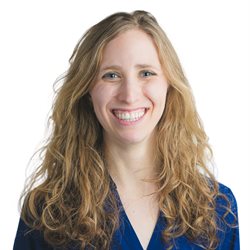
Why Pitch Matching Is Hard
Posted Sunday, November 13th 2016 by Andrea Grody
There is a difference between simple and easy. Something simple can be explained in a few words; something easy can be executed with minimal effort. There are plenty of simple things that are not at all easy. Take running a marathon: you can explain the task in three words - run 26.2 miles - but the execution requires months or years of training.
There is a difference between simple and easy. Something simple can be explained in a few words; something easy can be executed with minimal effort. There are plenty of simple things that are not at all easy. Take running a marathon: you can explain the task in three words - run 26.2 miles - but the execution requires months or years of training.
Matching pitch is similarly a simple concept - sing the pitch that you hear - that in execution can be quite difficult. New singers often think they are tone deaf because they have trouble matching pitch, and even accomplished singers who generally match pitch easily can get very frustrated if they suddenly struggle to be on pitch or hear their note.
So why is pitch matching hard? The short answer: mechanics, and sometimes acoustics. Many different mechanisms in your body working at the same time and in different ways, combined with the fact that sounds have a lot of ways they can be different from each other.
Now, a longer answer:
We have different vocal registers.
Every octave or so, our voice has a big “break”, where our vocal folds naturally shift gears like a bicycle. We also have smaller breaks every half-octave or tritone. For most people, these big breaks are around the note E in any given octave, and the half-breaks are around the note Bb. There are even quarter-breaks in the middle of each half-octave, usually around the notes G and C#.
We have habits that draw us to certain registers and favorite "spots" within these registers.
If you haven't spent much time identifying and switching between your vocal registers, you probably tend to aim for about the same note or notes every time you sing. The vocal range you speak in is usually the most comfortable range to access. Perhaps you also have a register you access when you get excited or angry and your voice goes very high, or when you're making cutesy sounds to babies or animals. If your speaking voice is higher, you may also have a silly low voice you use to imitate monsters or buffoonish people. If you're new to pairing these registers with specific pitches, you may not yet be able to aim for particular places within those registers. For example, when a note sounds high enough, your brain connects it to "cutesy" register, and you land somewhere in there, but you can't control where.
The place you land is probably pretty consistent based on our own personal physical habits we build up over time. The same way that your squats or lunges at the gym are usually about the same depth or length every time you exercise, your vocal muscles default to a place that feels most logical for them. Over time, you learn to stretch around your natural center and aim for different places within these registers.
Our vocal wingspan is only so far.
Stand up. Put yourself at arm's reach of an easy-to-grasp object, like a cup or a pencil. You should be able to reach out and grab it without shifting your feet.
Now take a step to one side and try again. You can probably still reach it, but you may have to turn your body to get to it.
Keep taking steps away until you get to the point where you can't reach the object without taking a step back toward it.
Your voice goes through a process not unlike this when you go from one note to another. Some notes are not very far apart; going from one to the other feels as easy as grabbing an object within arm's reach. Others are far enough apart that they require you to take a vocal “step.” This gives other factors an opportunity to knock you off balance.
Both of these things happen at the same time.
Imagine your vocal range as a long row of tables, like at a job fair. Each table is a vocal register: it stays in the same location no matter where you stand. Your vocal wingspan is how far you can reach along any given table without taking a step. As you walk past tables, the notes within your wingspan change. When we go from note to note while we sing, we are navigating both what table we should be standing in front of (what register we're in) and how many steps we do or don't need to get to that note (whether that note is within our vocal wingspan).
What if you're starting on a note that's on the edge of one register? Your next note may be less than a step away, but it may be in a different natural register. Usually when we're in this situation, we drag the register beyond its natural boundary. That's fine until we want to keep going beyond that point; suddenly there's a big break in tone.
Here's an example: “chest voice”, our lowest comfortable vocal range, naturally tops out around the E above middle C. Many people who want to learn to belt are comfortable carrying their chest voice up to about F#. That note may be a little strained, but it can be reached. Getting above G, though, suddenly feels very different and hard. That's because F# is about the limit of your vocal wingspan while you still have one foot comfortably in “chest” register. Past that, you have to take a step up into a new register, and it requires a different kind of technique to be strong on those notes.
The consonants and vowels we sing can affect pitch.
Take a deep breath in, and then breathe out on an S. Time yourself. How long could you hold the S for? Now try the same thing breathing out on an F. How long did the F last? Was it as long as the S?
Now try saying "BUH" a few times. Then say “PUH”. Which feels stronger? Does the consonant change how the letter sounds?
Different consonants use breath in different ways. Some letters require more air than others: you probably found that the F used more air than the S and was harder to hold out. Other kinds of consonants use air in very different ways: B and P are different from F and S - notice that you can't hold a B or a P as you breathe out - but even those two letters have different feelings.
One more exercise: try holding a note on the vowel OO. Now try the same one on an AH vowel. Do they feel different? Then go back and forth between OO and AH more quickly, like this: “OO-AH-OO-AH-OO-AH”. Does the pitch you're singing change as you go from vowel to vowel?
Changing vowels changes the shape of our resonating chambers (more on that below) and can also affect how much air is leaving the body at once. OO is a much smaller vowel than AH. More air can leave your mouth at a time when you're singing AH than when you're singing OO. It's like OO is water passing through a drinking straw while AH is water passing through a garden hose. Every other vowel lies somewhere on that spectrum as well.
When we sing, we're constantly using new consonants and vowels. Words have a lot of parts to them, and each of those parts is an opportunity for your pitch to be blown in one direction or another like a gust of wind.
The tone of the sound can affect pitch.
Pretend you're a three-year-old child whining to your mother. “WHY?!?!” Be really annoying about it.
Now pretend you're in a movie moving in slow motion. Say “NOOOOOO” very slowly. Maybe you're in an action movie saving your friend from an evil villain!
You probably noticed that the three-year-old child voice that you used was higher-pitched and brighter-sounding than the big, gaping, low “NOOOOO” sound.
These two examples at the extremes of our vocal spectrum show how our resonating chambers - your throat, mouth, and nose - can affect our voices. Discussing this in greater detail would fill a book, and indeed, many people have written books about this. But at a basic level, we can acknowledge that certain sounds and setups encourage us to reach in the direction of the annoying-child or slow-motion-movie extremes, and those tendencies can make us aim too high or too low for a pitch without realizing it.
All of these things happen at the same time, AND you still have to hear the pitch first.
Here are just a few ways that the note middle C can sound different:
- We can play it on a piano or play it on a saxophone.
- A woman can sing it, or a man can sing it.
- An opera singer can sing it, or Beyoncé can sing it.
- We can play it alone, or we can play it as part of a big C major chord.
- We can play it at the top of the C major chord or at the bottom of the chord.
- We can play it after playing a C minor chord, or after playing an F major chord, or after playing a cluster of notes that don't belong to any chord.
- We can play it in a song in the key of C where it feels like home base, or we can play it in a song in the key of F# where a C feels very out of place.
- We can sing it after singing the C the octave down, like the beginning of “Somewhere Over the Rainbow.”
- We can sing it after singing the C the octave up, like the chorus of “There's No Business Like Show Business.”
- We can play it on the downbeat of the bar or in the middle of the bar on an interesting rhythm after some other notes.
- We can do any of these things live or record it and play it back on headphones.
- We can play it back on bad computer speakers or a really good speaker system.
- We can put those speakers in the living room at home, or on a New York City subway platform, or in the middle of a forest.
Isn't it amazing that, despite all of these possible variations, we can still recognize middle C at all?
Different instruments or voices, harmonic and rhythmic contexts, and physical environments all make the same notes sound very different. The first part of matching pitch is hearing the note, and each of these factors can make a logical note feel completely new.
A big BUT…
Describing all of these factors may make pitch matching seem impossible. Luckily, we don't actually have to think about all of this every time we sing. Imagine I had written this article about why running is hard. I could have described lots of muscles you don't think about and made sidewalks and treadmills seem unbelievably complicated. But if I told you to run across the room, you could just run. Until you need to be able to run faster or longer, your natural technique will suit you just fine.
If you enjoy music and singing, then your body and mind are already involved in the music-making process. From there, the task is figuring out what factors are keeping your natural instincts from giving you the right result. Depending on where you are in your vocal journey, you may be starting by finding new vocal registers. Focusing on how your vowels change pitch may be more effective for you. Perhaps hearing the note is harder for you than singing it and you will focus on training your ear.
Singing the right pitch on the first try takes muscle coordination and skill, like learning to throw darts at a dartboard. When you first start learning, you may miss the dartboard altogether, never mind hitting the center! But with time and practice, you'll be hitting your target.

Andrea Grody
Senior Voice Teacher Associate, Musical Theatre Career Consultant, Resident Music Director
Andrea Grody was the original Music Director/Supervisor of the Tony Award-winning Broadway musical The Band’s Visit, is Musical Director/Supervisor & Vocal Arranger for the 2019 new musical adaptation of Tootsie, and dozens more critically-acclaimed musicals & performances across the country and NYC. Andrea discovered a love for vocal technique and voice teaching after completing her Voice Teacher Training & Certification course in 2015. She is currently developing Songwise, an online learning platform that teaches singers to read music.

NYVC Artist Spotlight: Isa Marina
Isa Marina is a New York based artist who's making waves in Latin Pop and R&B music. She recently sat down for an interview with NYVC's Kacey Velazquez to talk about her background, her new singles, "Down" and "Paid Up," and what's next for the burgeoning star.

Why does my voice sound different on recordings than it does in my head?
In this article, Tim Rosser explains why our recorded voices sound so different (and often unpleasant) to us, and how using recordings in practice can help singers make more accurate, objective improvements.

NYVC Artist Spotlight: Kamilah
Songwriter, Singer, and Artist, Kamilah shares insights into her writing process, inspirations, and artistic journey with NYVC's Kacey Velazquez...